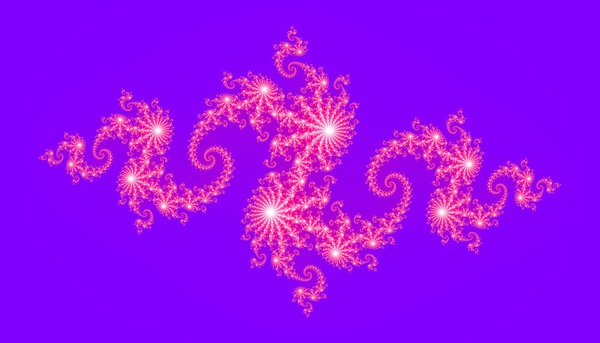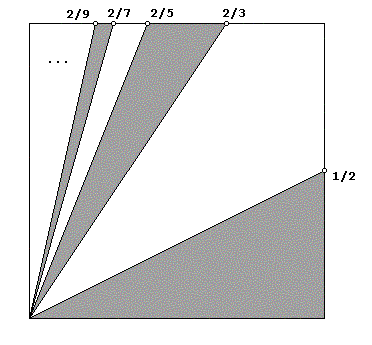 Author
Author |
Topic: Choosing Two Reals in (0,1) (Read 524 times) |
|
ThudnBlunder
Uberpuzzler
    

The dewdrop slides into the shining Sea
Gender: 
Posts: 4489
|
 |
Choosing Two Reals in (0,1)
« on: Dec 20th, 2004, 1:00am » |
 Quote Quote  Modify Modify
|
Choose two real numbers x,y at random in (0,1) with a uniform distribution.
What is the probability that [x/y] is even, where [ ] denotes the nearest integer function?
|
| « Last Edit: Dec 20th, 2004, 8:25am by ThudnBlunder » |
 IP Logged IP Logged |
THE MEEK SHALL INHERIT THE EARTH.....................................................................er, if that's all right with the rest of you.
|
|
|
Barukh
Uberpuzzler
    

Gender: 
Posts: 2276
|
Interesting! The attached drawing IMHO contains everything needed for the solution.
If I didn't make any mistakes, the answer is (5-pi)/4.
|
|
 IP Logged IP Logged |

|
|
|
Sir Col
Uberpuzzler
    

impudens simia et macrologus profundus fabulae

Gender: 
Posts: 1825
|
 |
Re: Choosing Two Reals in (0,1)
« Reply #2 on: Dec 21st, 2004, 12:22pm » |
 Quote Quote  Modify Modify
|
I got the same answer, but I imagined it the other way round, and I'm afraid that I need to take things much more slowly...
::
If x/y < 1/2, then [x/y]=0. We can rearrange this to get y > 2x and as x,y < 1, this corresponds to the area above the line y=2x, with x and y limited to 1: when y=1=2x, x=1/2, so area = (1/2)/2 = 1/4.
Otherwise, [x/y] will become 2n when 2n-0.5 < x/y < 2n+0.5; that is, 4n-1 < 2x/y < 4n+1.
4n-1 < 2x/y leads to y < 2x/(4n-1)
2x/y < 4n+1 leads to 2x/(4n+1) < y
Therefore, 2x/(4n+1) < y < 2x/(4n-1)
I always like to substitute numbers in to get a feel for things at each stage, so... when n=1,2,3,4,..., we get: 2x/5 < y < 2x/3, 2x/9 < y < 2x/7, and so on.
That is, for the first interval we want the area below y = 2x/3 and above y = 2x/5. We can calculate this by subtracting the area of the triangles, noting that x=1 is the limit of this region; that is, (2/3)/2-(2/5)/2=1/3-1/5.
In general, the area of each interval will be given by (2/(4n-1))/2-(2/(4n+1))/2 = 1/(4n-1) - 1/(4n+1).
So we get the infinite series, S = (1/3-1/5)+(1/7-1/9)+(1/11-1/13)+...
And as pi/4 = 1-1/3+1/5-1/7+... is a well known identity, 1/3-1/5+1/7-... = 1-pi/4 = S
Hence the probability we seek is 1/4+1-pi/4 = (5-pi)/4.
::
|
| « Last Edit: Dec 21st, 2004, 12:29pm by Sir Col » |
 IP Logged IP Logged |
mathschallenge.net / projecteuler.net
|
|
|
Eigenray
wu::riddles Moderator
Uberpuzzler
    

Gender: 
Posts: 1948
|
 |
Re: Choosing Two Reals in (0,1)
« Reply #3 on: Dec 21st, 2004, 1:37pm » |
 Quote Quote  Modify Modify
|
I got (2-log 2)/2 before I realized it was the nearest integer function, not the greatest integer (floor). It's neat either way.
|
| « Last Edit: Dec 21st, 2004, 1:40pm by Eigenray » |
 IP Logged IP Logged |
|
|
|
Barukh
Uberpuzzler
    

Gender: 
Posts: 2276
|
 |
Re: Choosing Two Reals in (0,1)
« Reply #4 on: Dec 22nd, 2004, 11:29pm » |
 Quote Quote  Modify Modify
|
on Dec 21st, 2004, 1:37pm, Eigenray wrote:| I got (2-log 2)/2 before I realized it was the nearest integer function, not the greatest integer (floor). It's neat either way. |
|
I made the same mistake 
|
|
 IP Logged IP Logged |
|
|
|
|
 WRITE MATH!
WRITE MATH!
 Home
Home  Help
Help  Search
Search  Members
Members  Login
Login  Register
Register WRITE MATH!
WRITE MATH!
 Home
Home  Help
Help  Search
Search  Members
Members  Login
Login  Register
Register